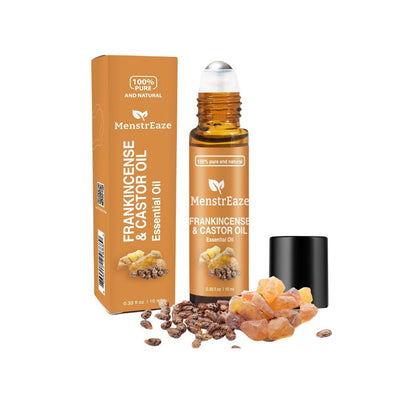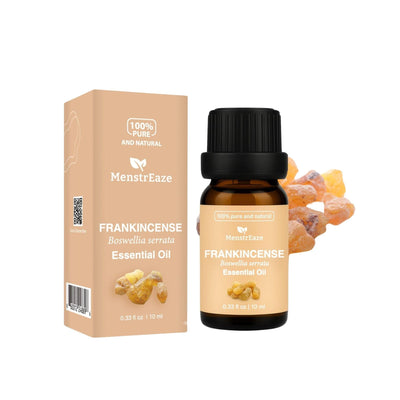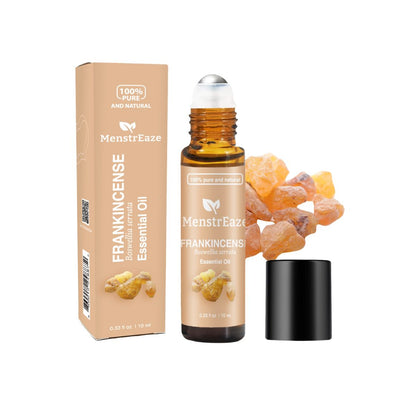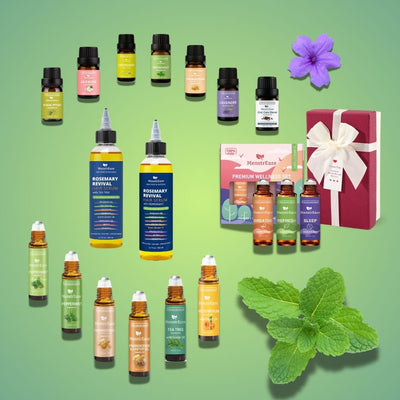The world of natural skincare offers a fascinating intersection of traditional wisdom and modern science, particularly when combining botanical carrier oils with potent essential oils. There's a growing desire for personalized skincare solutions, leveraging the unique properties of ingredients like Grape Seed Oil (GSO), Castor Oil (CO), and the revered Frankincense Essential Oil (FEO). Both GSO and CO are valued plant oils, while FEO boasts a rich history and contemporary appeal for its skin benefits [1]. However, choosing the right carrier oil is more than just a step for diluting essential oils safely; it's a fundamental formulation choice [3]. The carrier significantly influences the final blend's texture, how quickly it absorbs, how it feels on the skin, and potentially how effectively the essential oil's components are delivered [4]. This report offers a cosmetic chemist's perspective, comparing GSO and CO specifically in their roles as carriers for FEO, delving into their individual characteristics, potential synergies, and suitability for various skin health goals. Understanding these nuances is key, as the carrier oil dictates the sensory experience and performance profile of the entire blend, moving beyond generic claims to specific interactions within the GSO/CO + FEO system.
Understanding the Ingredients: Sources and Extraction Methods
The origin and processing of natural oils significantly impact their quality and suitability for skincare [7]. Differences in extraction can alter the presence and integrity of beneficial compounds [8].
Grape Seed Oil (GSO): From Vineyard Byproduct to Skincare Staple
Grape Seed Oil is derived from the seeds of grapes (Vitis vinifera), primarily sourced as a byproduct of the winemaking industry [10]. After grapes are pressed for juice, the remaining pomace (seeds, skins, residue) is processed [10]. Seeds are separated, cleaned, and dried before oil extraction [10]. Several methods are employed, each with distinct implications for the final oil's quality:
- Cold Pressing: This method involves mechanically pressing the seeds using expeller presses without applying external heat [10]. While frictional heat can raise the temperature slightly (up to about 40°C), it's generally low enough to preserve heat-sensitive compounds like Vitamin E, polyunsaturated fatty acids, and potent antioxidants like Oligomeric Proanthocyanidin Complexes (OPCs) [10]. Although this method typically results in a lower oil yield compared to others, the resulting oil is considered higher quality, retaining more natural nutrients and aromas, making it the preferred choice for cosmetic and food applications [12].
- Solvent Extraction: This common industrial method uses solvents, typically hexane, to dissolve the oil from crushed or flaked seeds [9]. The solvent is later removed through heating and distillation [13]. While this process achieves a much higher yield and is more cost-effective for large-scale production, it carries disadvantages for high-quality skincare oil [11]. The heat involved can degrade beneficial, heat-sensitive compounds, and there's a risk of toxic solvent residues remaining in the final product, necessitating significant refining [9].
- Supercritical Fluid Extraction (SFE) with CO2: This advanced technique uses carbon dioxide under high pressure and temperature, acting as a solvent to extract the oil [8]. SFE is considered a "green" technology as CO2 is non-toxic and environmentally benign [9]. It allows for extraction at relatively low temperatures, preserving thermally sensitive compounds effectively and potentially yielding an oil with a richer profile of extracted compounds compared to conventional methods [9]. However, the complexity and cost of the equipment limit its widespread use compared to pressing or solvent extraction [11].
- Emerging/Combined Methods: Research explores techniques like ultrasound pretreatment before extraction or ultrasound-assisted extraction [9]. These methods aim to enhance extraction efficiency, potentially increasing yield and improving oil quality by reducing extraction time or allowing for gentler conditions compared to traditional solvent methods [9]. Subcritical extraction is another less common alternative mentioned [11].
The extraction method is therefore a crucial factor determining GSO's suitability for skincare [8]. For maximizing the benefits derived from its rich antioxidant and fatty acid profile, cold-pressed GSO stands out as the superior choice [10]. Furthermore, the source itself introduces variability; factors like grape variety, climate, soil conditions, and the specific winemaking process can influence the seed composition and, consequently, the final oil profile, even when using the same extraction method [15]. This means not all GSO is identical, a point worth considering when selecting a product.
Castor Oil (CO): The Unique Oil from Ricinus Communis
Castor Oil is extracted from the seeds, commonly called beans, of the Ricinus communis plant, a shrub cultivated widely in tropical and subtropical regions like India, China, and Brazil [7]. The seeds are rich in oil, containing between 30% and 60% by weight [19]. Extraction typically involves:
- Mechanical Pressing (Cold/Hot): Seeds are mechanically pressed, often using screw or hydraulic presses, to expel the oil [26]. Cold pressing, done without added heat, yields a lower percentage of oil (around 45%) but is believed to better preserve the oil's natural components [24]. Hot pressing uses heat to increase extraction efficiency, yielding up to 80% of the available oil [26].
- Solvent Extraction: As with GSO, solvent extraction (commonly with hexane) is often used after mechanical pressing to extract the remaining oil from the seed cake, thereby maximizing the overall yield [26].
- Refining is Crucial: Regardless of the initial extraction method (cold-pressed or otherwise), crude castor oil requires significant refining before it is safe for cosmetic or pharmaceutical use [7]. Castor beans naturally contain ricin, a highly toxic protein, as well as allergenic compounds [22]. The refining process involves steps such as degumming (removing phospholipids), neutralization (removing free fatty acids), bleaching (removing color pigments), and deodorization (removing odor compounds) [26]. These steps effectively remove ricin and allergens, rendering the oil safe for its intended applications [22].
Therefore, while "cold-pressed" might indicate the initial extraction method for CO, the subsequent refining process is the critical factor determining its safety for skin application [23]. Users should ensure they are using refined castor oil suitable for cosmetic use [22]. The oil's high viscosity and unique chemical composition, dominated by ricinoleic acid, also mean that extraction and refining processes might require specific optimization to achieve efficiency and quality [7].
Frankincense Essential Oil (FEO): Ancient Resin, Modern Skincare
Frankincense Essential Oil is derived from the aromatic, hardened oleo-gum-resin collected from trees belonging to the Boswellia genus [28]. These trees are native to regions like India, East Africa, Somalia, and the Arabian Peninsula [28]. Incisions are made in the tree bark, causing a milky resin to exude, which then hardens into "tears" [28]. Common species used for essential oil production include Boswellia serrata (India), Boswellia carterii (East Africa/China), Boswellia sacra (Arabia), and Boswellia frereana (Somalia) [28]. It's noteworthy that B. carterii and B. sacra are now often considered the same species [32]. The raw resin typically contains essential oils (volatile aromatic compounds), alcohol-soluble resins (like boswellic acids), and water-soluble gums [28]. The extraction method determines which components are captured:
- Steam Distillation: This is the most prevalent method for producing FEO [29]. The resin, often ground into a powder to increase surface area, is subjected to steam [30]. The steam vaporizes the volatile essential oil components, which are then condensed and collected [30]. The yield of essential oil is typically low; one report cited obtaining 4.9 ml of oil from 110 g of resin after several hours of distillation [30]. Factors like distillation time and the physical state of the resin influence the final yield and potentially the quality [30].
- CO2 Extraction: Supercritical CO2 extraction can also be used [35]. This method can extract heavier, less volatile molecules compared to steam distillation, potentially resulting in an oil with a fuller aroma profile that is closer to the original resin and may possess a slightly different range of therapeutic compounds [35]. However, it is generally more expensive and less common than steam distillation [35].
- Hydrodistillation: In this method, the resin is distilled directly in boiling water [20].
- Oil Extraction/Infusion: It's also possible to create a frankincense extract by infusing the resin (often powdered) into a carrier oil (like GSO or CO) using gentle heat [34]. This process extracts the oil-soluble components, including the heavier, non-volatile resin acids like boswellic acids, which are known for their anti-inflammatory properties [34]. This resulting product is an "oleo-extract" or "resin extract" and is chemically distinct from the steam-distilled or CO2-extracted essential oil [34].
It is crucial to recognize the distinction between frankincense essential oil (containing primarily volatile aromatic compounds) and frankincense resin extracts or infusions (which contain non-volatile compounds like boswellic acids) [28]. While both may be referred to colloquially as "frankincense oil," their chemical compositions and potential therapeutic actions differ significantly [28]. Boswellic acids, often cited for anti-inflammatory benefits, are largely absent in the essential oil obtained via steam distillation [28]. Furthermore, the specific Boswellia species used can impact the resulting oil's aroma and chemical profile, adding another layer of potential variation [28].

A Chemist's Look Inside: Key Components for Skin Health
The distinct properties and benefits of GSO and CO stem directly from their unique chemical compositions, particularly their fatty acid profiles and antioxidant content [15].
Grape Seed Oil Profile: Lightweight Powerhouse
GSO is characterized by its high content of unsaturated fatty acids and valuable antioxidants [15]:
- High Linoleic Acid (Omega-6): This is the dominant fatty acid in GSO, typically comprising 60% to 76% of the total fatty acids [15]. Linoleic acid is an essential fatty acid, meaning the body cannot synthesize it and must obtain it from external sources [42]. For the skin, it plays a vital role in maintaining a healthy barrier function by being a key component of ceramides, particularly Ceramide 1, in the stratum corneum [15]. This helps prevent excessive transepidermal water loss (TEWL), keeping the skin hydrated [15]. Furthermore, linoleic acid helps regulate sebum production; skin prone to acne often exhibits lower levels of linoleic acid in its sebum, making it thicker and more likely to clog pores [15]. Supplementing linoleic acid topically may help normalize sebum consistency [15]. It also possesses anti-inflammatory properties and may contribute to reducing hyperpigmentation [15].
- Oleic Acid (Omega-9): Present in moderate amounts, ranging from 12% to 27% [15]. Oleic acid is a monounsaturated fatty acid known for its moisturizing and skin-softening properties [43].
- Vitamin E (Tocopherols & Tocotrienols): GSO is a notable source of Vitamin E, containing various forms including alpha-tocopherol and, significantly, gamma-tocotrienol [15]. Vitamin E is a potent fat-soluble antioxidant that protects skin cells from damage caused by free radicals generated by UV radiation and pollution [15]. It supports collagen health, helps maintain skin elasticity and suppleness, provides moisturizing benefits, and exhibits anti-inflammatory activity [15]. Its presence is better preserved through cold pressing [15].
- Antioxidants (Polyphenols/OPCs): Grape seeds are exceptionally rich in polyphenolic compounds, particularly Oligomeric Proanthocyanidin Complexes (OPCs) [15]. OPCs are renowned for their powerful antioxidant activity, reported to be significantly stronger than Vitamin C or Vitamin E [16]. These compounds help neutralize free radicals, protect against environmental stressors, support collagen repair, exert anti-inflammatory effects, and contribute to improved skin elasticity and a reduction in aging signs [15]. GSO also contains other phenols like resveratrol, catechins, and epicatechins [15]. It is worth noting, however, that the concentration of these water-soluble polyphenols in the final oil might be relatively low compared to grape seed extracts, due to solubility limitations in the lipid medium [21].
- Other Components: GSO contains smaller amounts of saturated fatty acids like palmitic acid (6-8%) and stearic acid (3-6%) [15]. Some sources also mention the presence of Vitamin A, B vitamins, Vitamin K, and phytosterols [15].
The defining characteristic of GSO for skincare is undoubtedly its high linoleic acid content [15]. This specific fatty acid profile is directly responsible for its lightweight feel, non-comedogenic nature, and particular suitability for balancing oily or acne-prone skin while simultaneously reinforcing the skin's barrier [15]. Combined with its significant Vitamin E and potent OPC antioxidant load, GSO offers a synergistic approach to skin health, providing protection against oxidative stress, soothing inflammation, and aiding repair – making it effective against both aging concerns and inflammatory conditions like acne [15].
Castor Oil Profile: The Ricinoleic Acid Specialist
Castor Oil possesses a chemical makeup that is quite distinct from most other vegetable oils, primarily due to one unique fatty acid [19]:
- Very High Ricinoleic Acid: This hydroxylated monounsaturated omega-9 fatty acid is the hallmark of Castor Oil, constituting an exceptionally high percentage, typically 85% to 95% [22]. The presence of a hydroxyl (-OH) group on the 12th carbon atom of its chain is unique among common fatty acids [19]. This hydroxyl group imparts increased polarity to the molecule and allows for chemical reactions not possible with other oils, making CO valuable industrially [19]. For skincare, ricinoleic acid is credited with CO's primary benefits: potent anti-inflammatory and analgesic (pain-relieving) effects, significant antimicrobial (antibacterial and antifungal) activity, strong moisturizing and emollient properties (acting as an occlusive), and promotion of wound healing [39]. It is also largely responsible for the oil's characteristic high viscosity [23]. Claims regarding stimulation of hair growth are common but less scientifically substantiated [43].
- Other Fatty Acids: Castor Oil contains much smaller amounts of other fatty acids compared to ricinoleic acid [22]. These include oleic acid (omega-9, 2-6%), linoleic acid (omega-6, 1-5%), stearic acid (saturated, 0.5-1%), and palmitic acid (saturated, 0.5-1%) [22]. These contribute minimally to the oil's overall properties compared to ricinoleic acid.
- Vitamin E: Tocopherols are present, providing antioxidant capacity [53].
- Other Components: Various minor constituents like flavonoids, phenolic acids, amino acids, terpenoids, and phytosterols have been reported [43]. Undecylenic acid, known for its antifungal properties, can be derived from ricinoleic acid through chemical processes [19].
Essentially, Castor Oil's identity and functionality are overwhelmingly defined by ricinoleic acid [22]. This single component drives its therapeutic potential, making it fundamentally different from oils like GSO, which have a more diverse blend of active fatty acids and antioxidants [15]. The potent anti-inflammatory and antimicrobial actions suggest CO functions as more than just a moisturizer; it's an active ingredient capable of addressing specific skin conditions involving inflammation or microbial factors, positioning it as a treatment-oriented oil [39].
Table 1: Comparative Chemical Profile of Grape Seed Oil and Castor Oil
|
Feature |
Grape Seed Oil (Cold-Pressed) |
Castor Oil (Refined) |
|
Primary Fatty Acid (%) |
Linoleic Acid (Omega-6): 60-76% 15 |
Ricinoleic Acid (Omega-9): 85-95% 22 |
|
Other Key Fatty Acids (%) |
Oleic Acid (Omega-9): 12-27% 15 |
Oleic Acid (Omega-9): 2-6% 22 |
|
Palmitic Acid: 6-8% 15 |
Linoleic Acid (Omega-6): 1-5% 22 |
|
|
Stearic Acid: 3-6% 15 |
Palmitic Acid: 0.5-1% 22 |
|
|
Stearic Acid: 0.5-1% 22 |
||
|
Key Vitamins |
Vitamin E (Tocopherols, Tocotrienols) 15 |
Vitamin E (Tocopherols) 53 |
|
Key Antioxidants / Unique Compounds |
OPCs (Oligomeric Proanthocyanidins), Resveratrol, Other Polyphenols 15 |
Ricinoleic Acid (Hydroxylated) 19 |
Note: Percentages are typical ranges and can vary based on source, variety, and processing.7
Grape Seed Oil in Action: Benefits for Your Skin (Alone and with Frankincense)
GSO offers a unique combination of properties making it beneficial for various skin concerns, both when used alone and potentially enhanced when combined with FEO [16].
Standalone Benefits:
- Hydration: GSO is prized for its lightweight texture that absorbs rapidly into the skin without leaving a heavy or greasy feeling [15]. Its high linoleic acid content helps fortify the skin's natural barrier, reducing transepidermal water loss and locking in moisture [15]. This makes it an excellent daily moisturizer, suitable even for use under makeup [16]. Applying it to slightly damp skin can maximize its hydrating effects [16].
- Anti-Aging: The oil is rich in powerful antioxidants, including Vitamin E and especially OPCs, which combat free radical damage from UV exposure and environmental pollutants – key drivers of premature aging [15]. These components may help support collagen synthesis and repair, improve skin elasticity and firmness, and diminish the appearance of fine lines and wrinkles [15]. Some sources also note natural astringent properties that can contribute to a tighter skin appearance [50].
- Acne and Oil Control: GSO's non-comedogenic nature (comedogenic rating of 1) means it's unlikely to clog pores, making it a suitable choice for acne-prone individuals [15]. Its high linoleic acid content is particularly relevant, as it can help balance the sebum composition in oily skin, which is often deficient in this fatty acid [15]. Additionally, GSO exhibits antimicrobial properties against bacteria like Staphylococcus aureus and Escherichia coli, which can contribute to breakouts [49]. Its anti-inflammatory effects further help soothe existing acne lesions and associated redness [15]. It may also aid in lightening post-acne marks or scars [50].
- Inflammation Soothing: The anti-inflammatory action derived from linoleic acid, Vitamin E, and polyphenols makes GSO beneficial for calming various forms of skin irritation and redness [15]. It's often recommended for sensitive skin types and may help manage symptoms associated with eczema, psoriasis, or rosacea [15].
- Skin Tone & Scars: The antioxidant proanthocyanidin, along with Vitamin E, may contribute to a more even skin tone by reducing hyperpigmentation, such as melasma or sunspots [15]. Its wound-healing support properties can also help minimize the appearance of scars [16].
- Suitability: Due to its profile, GSO is particularly well-suited for individuals with oily, combination, acne-prone, sensitive, and mature skin types [15]. It is generally considered gentle and well-tolerated, although patch testing is always recommended as a precaution [46].
Synergy with Frankincense Essential Oil (FEO):
When GSO is used as a carrier for FEO, their properties can complement each other effectively [68]:
- Delivery System: GSO's very light texture and rapid absorption provide an elegant, non-greasy vehicle for delivering FEO to the skin [15]. This is ideal for users who dislike heavy oils but want the benefits of FEO [18].
- Enhanced Anti-Aging: Combining GSO's potent antioxidants (Vitamin E, OPCs) with FEO's recognized antioxidant, cell-regenerating, and skin-tightening properties creates a powerful synergistic blend aimed at combating multiple signs of aging, including wrinkles, loss of firmness, and age spots [1].
- Balanced Acne Care: GSO's suitability for oily and acne-prone skin (non-comedogenic, linoleic acid-rich) pairs well with FEO's potential astringent, anti-inflammatory, and antimicrobial actions [1]. This blend offers a way to address breakouts and balance oil production without contributing to pore congestion [15].
- Combined Soothing Effects: Both GSO and FEO possess anti-inflammatory properties [1]. Their combination may offer enhanced soothing benefits for red, irritated, or sensitive skin conditions [46].
In essence, GSO is a versatile oil addressing hydration, aging, and inflammation simultaneously [16]. As a carrier for FEO, it excels in creating lightweight, fast-absorbing blends suitable for delivering FEO's benefits, particularly to oily, combination, sensitive, or mature skin types, without undesirable heaviness [18].
Castor Oil in Action: Benefits for Your Skin (Alone and with Frankincense)
Castor Oil offers a distinct set of benefits, largely driven by its high concentration of ricinoleic acid, making it a unique player in skincare formulations [22].
Standalone Benefits:
- Deep Moisturization & Hydration: CO is a highly effective emollient and occlusive moisturizer [39]. Its richness in ricinoleic acid allows it to form a protective layer on the skin, significantly reducing transepidermal water loss and locking in moisture [39]. This makes it particularly beneficial for treating very dry, dehydrated skin, chapped lips, and rough patches on elbows or knees [55]. It can improve skin softness and smoothness [56].
- Anti-Inflammatory & Soothing: The dominant fatty acid, ricinoleic acid, exhibits potent anti-inflammatory and pain-relieving (analgesic) properties [39]. Topically applied, CO can help soothe various inflammatory skin conditions, reduce redness, swelling, and puffiness (like under-eye bags), and alleviate discomfort from issues such as dermatitis, eczema, psoriasis, sunburn, insect bites, or even muscle aches and arthritis pain [39].
- Antimicrobial Activity: CO possesses notable antibacterial and antifungal properties, again attributed mainly to ricinoleic acid [39]. It may help inhibit the growth of bacteria associated with acne (S. aureus) and fungi like Candida albicans, which can cause oral issues or skin infections [39]. This antimicrobial action contributes to its use in some wound care preparations [56].
- Wound Healing Support: By maintaining a moist environment, preventing sores from drying out, reducing inflammation, and inhibiting microbial growth, CO can support the healing process for minor cuts, abrasions, pressure ulcers, and other wounds [56]. It may also promote tissue growth [56].
- Potential Anti-Aging/Complexion Benefits: The antioxidants in CO help combat free radical damage [53]. Some evidence and traditional use suggest it may support collagen production, improve skin elasticity, reduce the appearance of wrinkles and fine lines, and help even out skin tone and texture [48]. Studies have also explored its potential for reducing infraorbital hyperpigmentation (dark under-eye circles) [53].
- Suitability: CO is best suited for individuals with dry, very dry, mature, or inflamed skin requiring intensive moisturization and soothing [53]. Although it has a low comedogenic rating of 1 [56], its extremely thick and occlusive nature may not be well-tolerated by those with oily or acne-prone skin, despite its antimicrobial claims [53]. Caution is also advised for sensitive skin types, as CO can sometimes cause irritation or allergic reactions [57]. Patch testing is crucial [65]. Due to its thickness, it's often recommended to dilute CO with lighter carrier oils to improve its texture and spreadability [57].
Synergy with Frankincense Essential Oil (FEO):
Combining CO with FEO results in a blend with potent therapeutic potential [89]:
- Sustained Delivery: CO's thick, occlusive nature creates a barrier on the skin that slows down evaporation and absorption [5]. This could potentially provide a more sustained release of FEO's components into the skin over time compared to lighter carriers.
- Potent Anti-Inflammatory Action: The combination of CO's powerful anti-inflammatory ricinoleic acid and FEO's own anti-inflammatory compounds results in a highly effective blend for calming significant irritation, inflammation, or pain associated with conditions like eczema, psoriasis, or even localized joint discomfort [1].
- Enhanced Repair and Regeneration: Both oils contribute to skin repair and wound healing processes [1]. The blend is therefore well-suited for targeting scars, blemishes, stretch marks, or areas needing intensive regeneration [1].
- Deep Nourishment for Dry/Mature Skin: The blend offers the intense, lasting hydration of CO combined with the rejuvenating, toning, and anti-aging effects of FEO [1]. This makes it ideal for very dry or mature skin needing deep nourishment, barrier support, and wrinkle reduction [89].
Castor oil's value proposition lies heavily in the potent biological activities driven by ricinoleic acid, positioning it as an active, treatment-focused carrier [22]. When combined with FEO, it creates a powerful blend geared towards intensive soothing, repair, and hydration, often best utilized for targeted applications rather than all-over facial use for every skin type, owing to its unique texture and potential for sensitivity [89].
Head-to-Head: GSO vs. CO as Frankincense Carriers
Choosing between GSO and CO as a carrier for FEO depends heavily on understanding their key differences in physical properties, skin interaction, and safety profile [4].
Texture, Feel, and Absorption Rate
The most immediate difference between GSO and CO lies in their physical characteristics, which profoundly impact the user experience of a frankincense blend [5]:
- Grape Seed Oil (GSO): Possesses a very lightweight and thin viscosity, often described as having a "dry" feel on the skin [15]. It absorbs remarkably quickly and easily, leaving little to no greasy or oily residue behind [16]. This makes it highly desirable for individuals who dislike the sensation of heavy oils on their skin and allows for comfortable daytime use, even under cosmetics [46]. When blended with FEO, GSO facilitates rapid delivery of the essential oil to the skin's surface layers [80]. Its scent is generally neutral or only faintly nutty and sweet, allowing the aroma of the FEO to dominate the blend [15].
- Castor Oil (CO): Is characterized by its exceptionally thick, heavy, and viscous texture [5]. Its absorption into the skin is very slow; it tends to remain on the surface for an extended period, creating a noticeable occlusive barrier [5]. This can feel heavy, sticky, or greasy to many users [48]. Consequently, CO-based blends are often better suited for nighttime application, targeted treatments on specific areas, or use on the body or scalp where slow absorption might be acceptable or even advantageous (e.g., for deep conditioning) [57]. This slow absorption implies a potentially slower, more sustained release of FEO compared to GSO [105]. CO also possesses a distinct, somewhat earthy odor that some may find unpleasant and which could potentially mask or alter the desired fragrance of the FEO [5]. Due to its thickness and slow absorption, CO is frequently recommended to be diluted with other, lighter carrier oils to improve its cosmetic elegance [57].
This stark contrast in texture and absorption is arguably the most critical factor influencing the choice between GSO and CO for an FEO blend [5]. GSO offers a light, fast, cosmetically pleasing option suitable for broader facial application, while CO provides a heavy, occlusive, treatment-focused base [15]. Furthermore, for those prioritizing the aromatherapy aspect of FEO, GSO's neutral scent offers a distinct advantage over CO's potentially interfering odor [5].
Comedogenicity (Pore-Clogging Potential)
Comedogenicity refers to the likelihood of an ingredient clogging pores and potentially leading to comedones (blackheads, whiteheads) [41]. It's typically rated on a scale from 0 (will not clog pores) to 5 (high likelihood of clogging pores) [41]. It's important to remember this scale is a guideline, and individual skin reactions can vary based on skin type, formulation, and other factors [41]. Factors like fatty acid composition (high linoleic acid is generally less comedogenic than high oleic acid), viscosity, and susceptibility to oxidation can influence an oil's rating [44].
- Grape Seed Oil (GSO): Consistently receives a low comedogenic rating, typically 1 [18]. It is widely considered non-comedogenic or having a very low probability of clogging pores [15]. Its high content of linoleic acid is thought to contribute significantly to this low rating, making it particularly suitable for oily and acne-prone skin types [15].
- Castor Oil (CO): Also consistently rates low on the scale, typically a 1 [56]. This indicates it is formally considered non-comedogenic or very unlikely to clog pores [48]. It's often deemed suitable for sensitive skin based on this rating [86]. However, its extremely thick texture presents a potential caveat [48]. Despite the low rating, some sources advise caution when using it on acne-prone skin, possibly because its heavy, occlusive nature could trap dead skin cells or bacteria, or simply due to individual sensitivities not captured by the rating alone [53]. Interestingly, some proponents suggest its properties might even help cleanse pores [66].
While both oils share a favorable comedogenic rating of 1, the practical implications differ. GSO's light texture and beneficial linoleic acid content align well with the needs of breakout-prone skin, making it a generally safer bet in this context [15]. Castor Oil's low rating might seem surprising given its viscosity, and while technically non-comedogenic, its heavy feel warrants a more cautious approach for individuals prone to congestion [48]. For blending with FEO, the low rating of both carriers suggests that pore-clogging issues are unlikely to stem from the carrier itself, placing more emphasis on proper FEO dilution and individual skin tolerance to the overall blend [3].
Potential Side Effects & Sensitivities (Carrier & FEO Interactions)
Safety is paramount when using botanical oils, especially concentrated essential oils like FEO [3]. Potential risks can arise from the carrier oil, the essential oil, or their combination.
- General Essential Oil Considerations: FEO, like all essential oils, is highly concentrated and must be diluted in a carrier oil before topical application to avoid adverse reactions [3]. Undiluted application can lead to skin irritation (contact dermatitis), characterized by redness, itching, burning, or blistering [110]. Allergic reactions, though less common, can also occur, potentially involving hives or even respiratory symptoms if inhaled intensely [2]. A patch test – applying a small amount of the diluted blend to an inconspicuous area (like the inner wrist or elbow) and waiting 24-48 hours to check for reactions – is an essential safety step before applying any new blend more widely [6]. Recommended dilution ratios for facial application are typically low, around 1-2% (e.g., 3-6 drops of FEO per 10 ml or 2 teaspoons of carrier oil) [3].
- Grape Seed Oil (GSO) Specifics: GSO is generally considered very safe and low-risk for topical use, with allergic reactions being relatively uncommon [46]. While oral grape seed extract has potential interactions (e.g., with blood thinners), these are typically not a concern for standard topical application unless a specific allergy exists or there's unusually high systemic absorption [68].
- Castor Oil (CO) Specifics: Refined CO (with ricin removed) is safe for cosmetic use [22]. However, it has a higher potential to cause skin irritation or allergic contact dermatitis compared to GSO, particularly in individuals with sensitive skin, eczema, or other forms of dermatitis [57]. Its occlusive nature might also trap heat or other potential irritants against the skin [39]. While primarily used topically in skincare, it's important to note that oral ingestion can cause significant gastrointestinal side effects [59].
- Frankincense Essential Oil (FEO) Specifics: FEO itself can cause skin sensitivity, irritation, or allergic reactions in susceptible individuals [2]. While evidence is limited, there's a theoretical possibility of interaction with certain medications, warranting caution [2]. Proper dilution is crucial [2].
- Blend Interactions & Considerations: Combining FEO with a carrier oil involves considering the potential risks of both components [3]. Using a carrier oil like CO, which itself carries a slightly higher risk of irritation for some individuals compared to GSO, may increase the overall potential for sensitivity in the final blend [57]. This cumulative risk underscores the critical importance of patch testing the specific FEO-carrier blend before use [6]. While direct chemical reactions between the fatty acids of GSO/CO and FEO components are not explicitly documented in the provided materials, the difference in polarity between the largely non-polar GSO and the more polar CO (due to ricinoleic acid's hydroxyl group) could theoretically influence how well FEO dissolves or remains stable within each carrier, though this remains a point of chemical consideration rather than proven interaction [19].
Table 2: GSO vs. CO Carrier Comparison Summary for Frankincense Blends
|
Feature |
Grape Seed Oil (GSO) Carrier |
Castor Oil (CO) Carrier |
|
Texture / Viscosity |
Very light, thin, "dry" [15] |
Very thick, heavy, viscous [5] |
|
Absorption Rate |
Very fast [16] |
Very slow [5] |
|
Skin Feel |
Non-greasy, quickly absorbed [16] |
Heavy, potentially sticky/greasy, occlusive [48] |
|
Comedogenicity Rating (0-5) |
1 (Very Low) [18] |
1 (Very Low) [56] |
|
Typical Scent |
Neutral / Faintly nutty [15] |
Distinct / Earthy [5] |
|
Key Blend Benefit Focus (w/ FEO) |
Antioxidant, Anti-aging, Balancing, Clarity [1] |
Anti-inflammatory, Soothing, Deep Hydration, Repair [ [1] |










